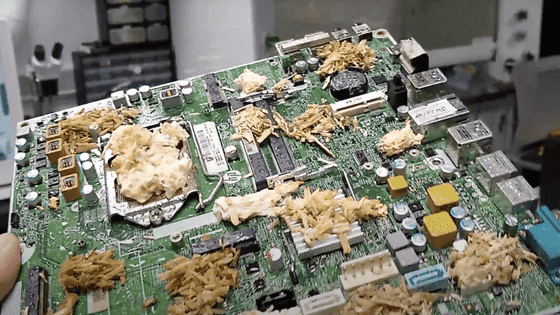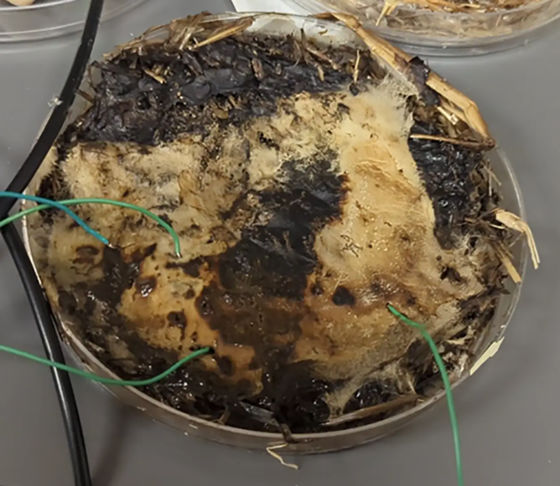Shiitake mushrooms could replace computer memory chips

Researchers at Ohio State University have announced a study using the mycelium of shiitake mushrooms as memory chips for computers, potentially offering a low-cost, environmentally friendly alternative to memory chips in the future.
Sustainable memristors from shiitake mycelium for high-frequency bioelectronics | PLOS One

Scientists Built a Working Computer Memory Out of Shiitake Mushrooms : ScienceAlert
https://www.sciencealert.com/scientists-built-a-working-computer-memory-out-of-shiitake-mushrooms
In computers, 'memristors' are devices that can store and read/write data. While typical transistors transmit information by switching between two values, '0' and '1,' depending on the charge they carry, memristors , passive elements with the ability to memorize the electrical charge they pass through and change their resistance, are expected to operate like the synapses in the human brain, enabling chips to be smaller and more powerful than those using conventional transistors.
A 'brain-like chip' that can memorize information like the human brain will be developed - GIGAZINE

By integrating memory and computing areas, memristors are expected to lead to energy savings, high-density memory integration, and the development of new design architectures. However, the materials and manufacturing of memristor elements generally require rare earth elements and high-purity semiconductor processes, posing challenges in terms of manufacturing costs and environmental impact. Furthermore, 'neural organoids,' small brain models used in the development of computers that function like the brain, require careful management in complex culture equipment, making maintenance difficult.
A research team at Ohio State University has therefore turned to shiitake mushrooms as an alternative. Shiitake mushroom mycelium (aggregates of hyphae) possesses properties that allow it to transmit electrical signals and exhibit resistance changes through its interconnected hypha network, making it appear as if it is processing information efficiently. In particular, materials derived from shiitake mushrooms have a porous structure that makes them highly conductive and resistive, and they also have excellent radiation and stress resistance. By utilizing these properties in the development of computing systems, it is possible to design environmentally sustainable 'fungal memristors' that do not require scarce materials.
What are the benefits of using mushrooms as part of a computer? - GIGAZINE

In this research, the researchers first cultivated mycelium from shiitake mushroom spores. After cultivation, the mycelium was dried to ensure stable storage. Metal electrodes were then connected to the mycelium, and electrical stimulation was applied with a specified waveform, voltage, and frequency, and the input and output voltage and current were measured.

We also incorporated the mycelium device as a voltage divider and evaluated its operating frequency and accuracy by repeatedly performing write/read operations using a microcontroller. If the write and read operations are quantitatively possible, it can function as a memory.
In addition to changes in resistance, the researchers observed a 'hysteresis loop' in the shiitake mushroom mycelium, which is the change in current response when the voltage is increased or decreased. A hysteresis loop is a phenomenon in which the current response changes depending on the voltage history. This indicates that mycelium 'remembers' past electrical signals, demonstrating its ability to electrically record information. Furthermore, in write/read circuit experiments, the researchers achieved approximately 90% accuracy at a switching frequency of approximately 5.85 kHz, operating at about half the speed of the slowest commercially available memristors. This is a very promising first step, the researchers report.
'If we could develop a microchip that mimics real neural activity, it would require less power when the machine is not in use, especially when it is idle,' said John LaRocco, lead author of the paper. 'This could have huge computational and economic benefits. Furthermore, the mycelium memristors would be achievable with the resources we have today, from homemade compost to large-scale cultivation factories.'
Although it was demonstrated that shiitake mushroom mycelium can be used as a memristor, this research was only on an experimental scale, and challenges remain in reducing the size and increasing the density before it can be applied to large-scale integrated circuits. Furthermore, due to the short experimental period, further verification is required regarding long-term data storage, environmental resistance, and resistance to degradation.
Related Posts:





